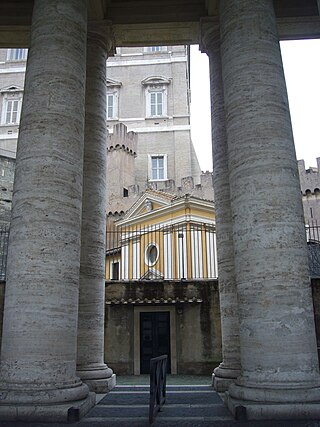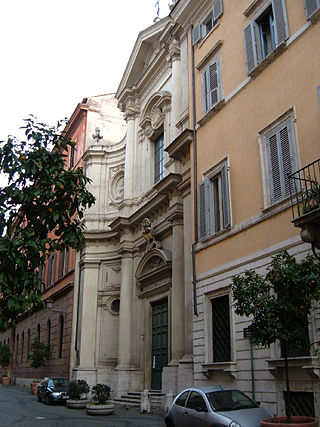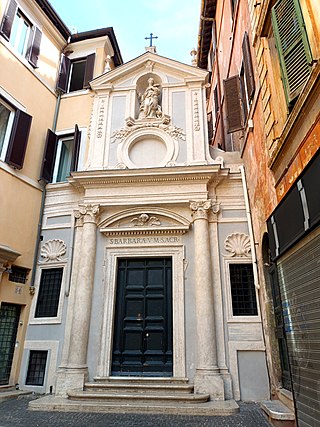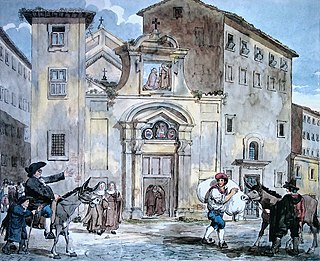
The Minor Basilica of St. Mary in Domnica alla Navicella, or simply Santa Maria in Domnica or Santa Maria alla Navicella, is a Roman Catholic basilica in Rome, Italy, dedicated to the Blessed Virgin Mary and active in local charity according to its long tradition. It is one of the best examples of the so-called "Carolingian renaissance" in Rome. It has been the titular church of Cardinal Marcello Semeraro since 28 November 2020.

Church of the Holy Spirit in the Saxon District is a 12th-century titular church in Rome, Italy. It is in Borgo Santo Spirito, a street which got its name from the church, placed in the southern part of Rione Borgo. The current holder of the titulus is Cardinal-Deacon Dominique Mamberti. It has been the official sanctuary of Divine Mercy since 1994.

The Church of the Most Holy Name of Mary at the Trajan Forum is a Roman Catholic church in Rome, Italy. This church should not be confused with the church Santissimo Nome di Maria in Via Latina in south-east Rome.

Santa Caterina dei Funari is a church in Rome in Italy, in the rione of Sant'Angelo. The church is mainly known for its façade and its interior with frescoes and paintings.
San Bernardo della Compagnia was a small church in Rome, next to Trajan's Column, dedicated to Saint Bernard and the Virgin Mary.

The Church of Saints Martin and Sebastian of the Swiss is a Roman Catholic oratory in Vatican City. The church was built by Pope Pius V in 1568 to serve as a private chapel for the Pontifical Swiss Guards, whose barracks are located next to Porta San Pellegrino, close to the Apostolic Palace. It is considered the national church of Switzerland in Rome.

The Chiesa di Santa Rita da Cascia in Campitelli is a deconsecrated church in Rome (Italy), in the rione Sant'Angelo; it is located in Via Montanara, at the crossroad with Via del Teatro Marcello. The church formerly rose on the preexisting church of San Biagio de Mercato, dating at least to the 11th-century. The remains of St Blaise putatively were discovered during the dismantling of Santa Rita.

San Pantaleo is an ancient church located on a piazza of the same name along Corso Vittorio Emanuele II in the Parione neighborhood of Rome, Italy. It shares the Piazza with the Museo di Roma in Palazzo Braschi. A church at the site dates from the 12th-century, but the present facade (1807) is in a Neoclassical style and the interiors were elaborated in a Baroque style.

Santo Spirito dei Napoletani is a Roman Catholic church on via Giulia, in the Regola rione of Rome. It was the national church of the Kingdom of the Two Sicilies and is now the regional church for Campania.

San Giovanni Battista dei Genovesi is a Roman Catholic church on via Anicia in the Trastevere district of Rome. It is the regional church for Genoa.

Santissimo Sudario all'Argentina or Santissimo Sudario dei Piemontesi is a church in Rome, sited on the via del Sudario in the Sant'Eustachio district. It is the subsidiary church of the military orders in Italy. It was also once the national church of the Kingdom of Sardinia and is now the regional church for Piedmont and Sardinia. It houses a replica of the Turin Shroud.

Santa Caterina da Siena is a church in Rome dedicated to Catherine of Siena. It is sited on via Giulia in the Regola district.

Santo Stanislao dei Polacchi, also known as San Stanislao alle Botteghe Oscure, is a Roman Catholic church in Rome, sited on Via delle Botteghe Oscure in the Sant'Angelo rione. It is the national church of Poland in Rome.

Natività di Gesù is a church on Piazza Pasquino in the Parione rione of Rome. It is the national church in Rome of the Democratic Republic of Congo.
The church of Sant'Egidio in Borgo, ...a Borgo, or ...in Vaticano, is a Roman Catholic oratory in Vatican City dedicated to Saint Giles.

Santa Barbara dei Librai is a small Roman Catholic church in Rome, Italy. It was once known as Santa Barbara alla Regola after the rione in which it was located. Today it now considered within the rione of Parione, near the Campo de' Fiori.

San Sebastiano de Via Papae was a small church in the Sant'Eustachio rione of Rome that was demolished in the 1590s in order to enable the construction of the church of Sant'Andrea della Valle.

Santi Maria e Gallicano is a Roman Catholic church in Rome, in the district of Trastevere, along via di S. Gallicano, 2.

Santi Andrea e Bartolomeo is a Catholic church in Rome (Italy), in the Rione Monti, on Via Santo Stefano Rotondo.

Sant'Urbano a Campo Carleo was a church in Rome (Italy), in the Rione Monti, on the former Via Alessandrina.




















